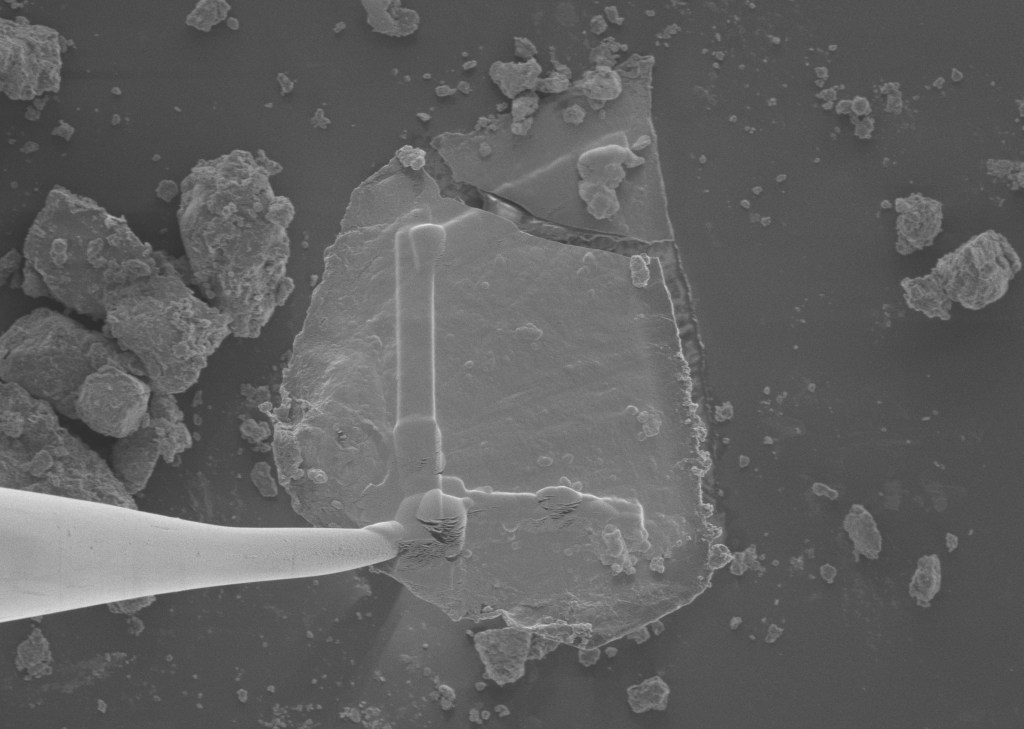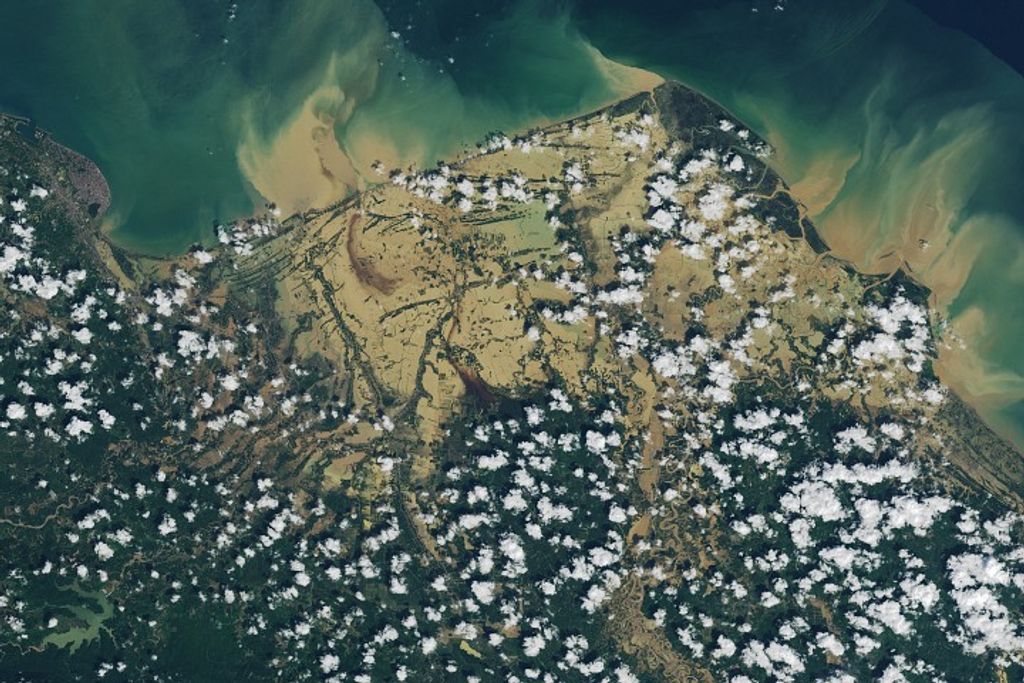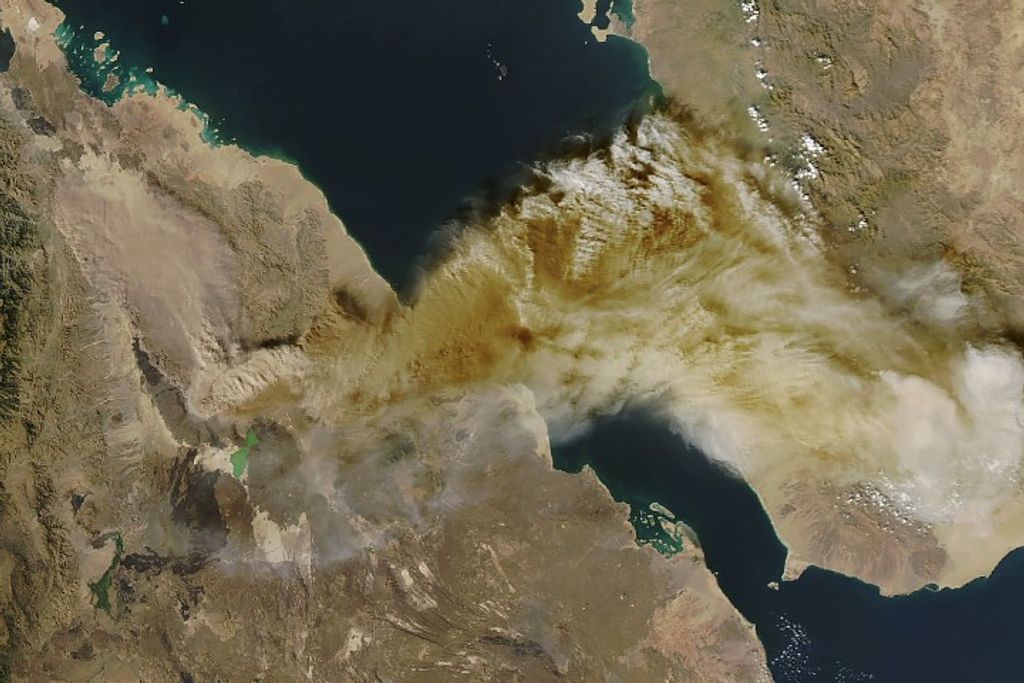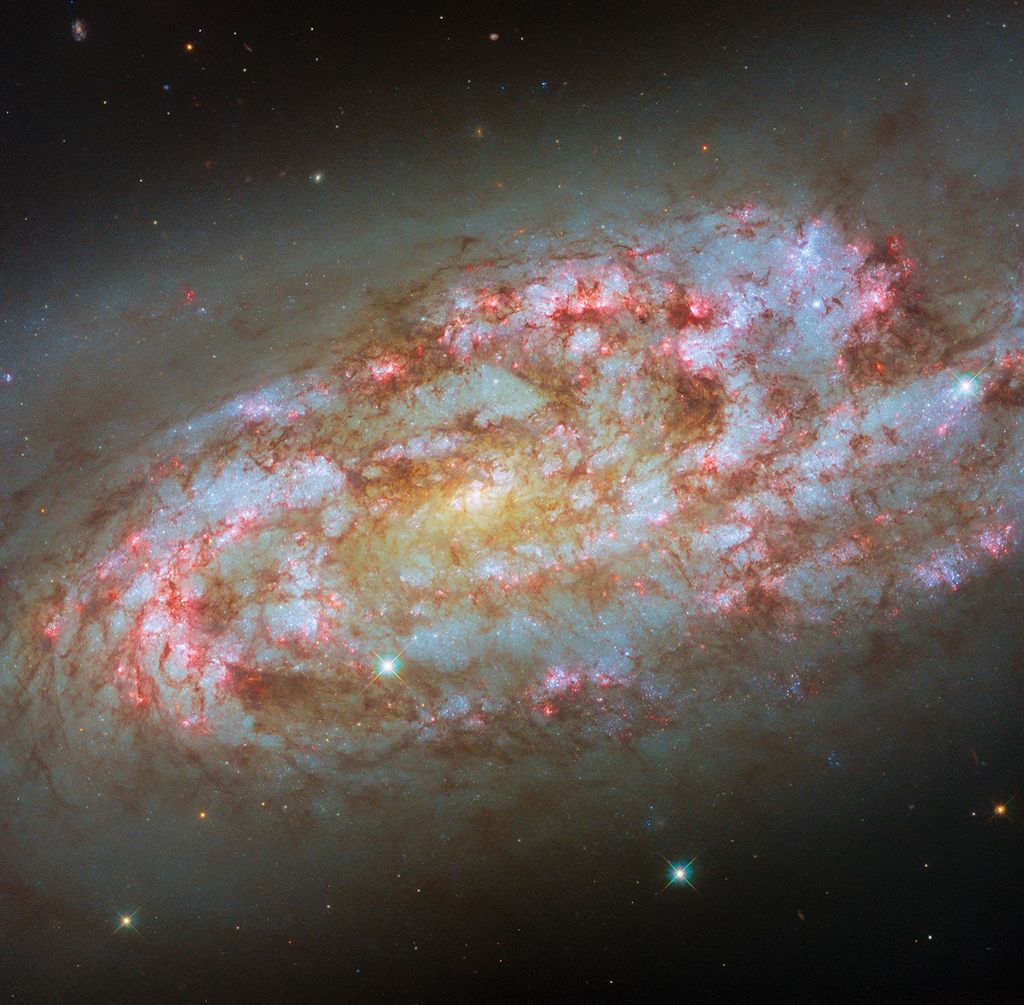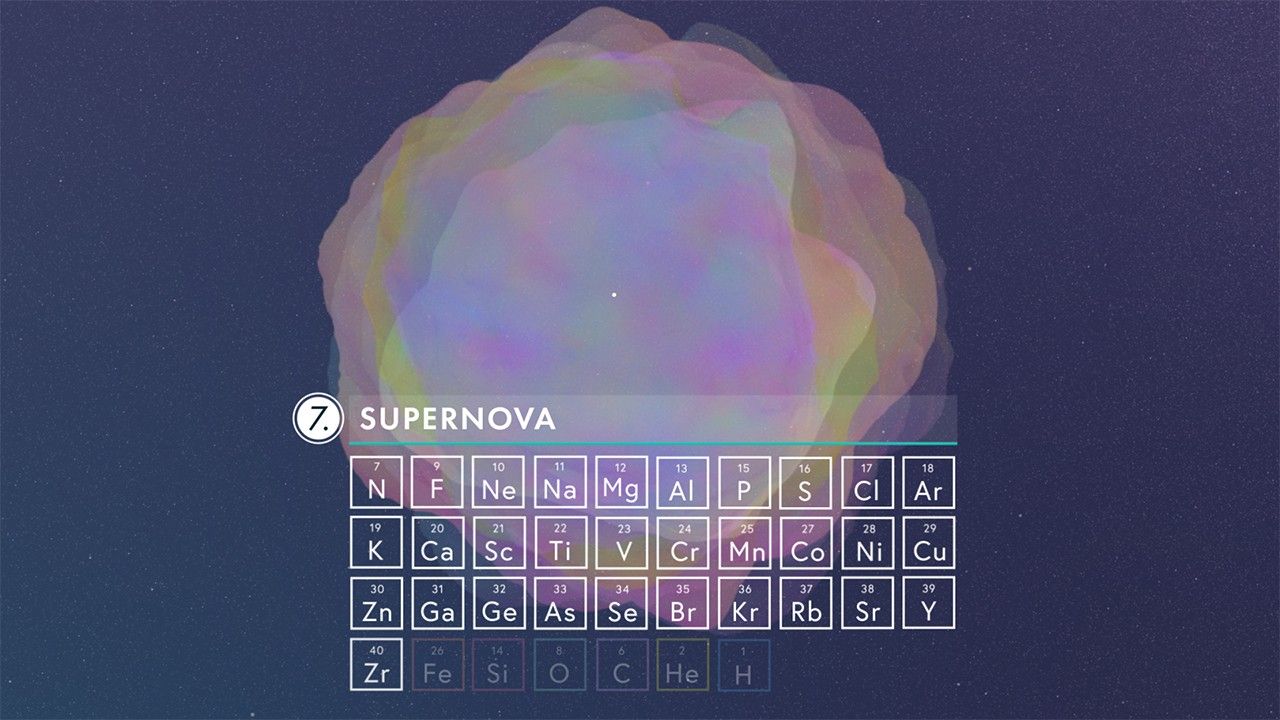1 min read
Massive Stars: Engines of Creation Infographic
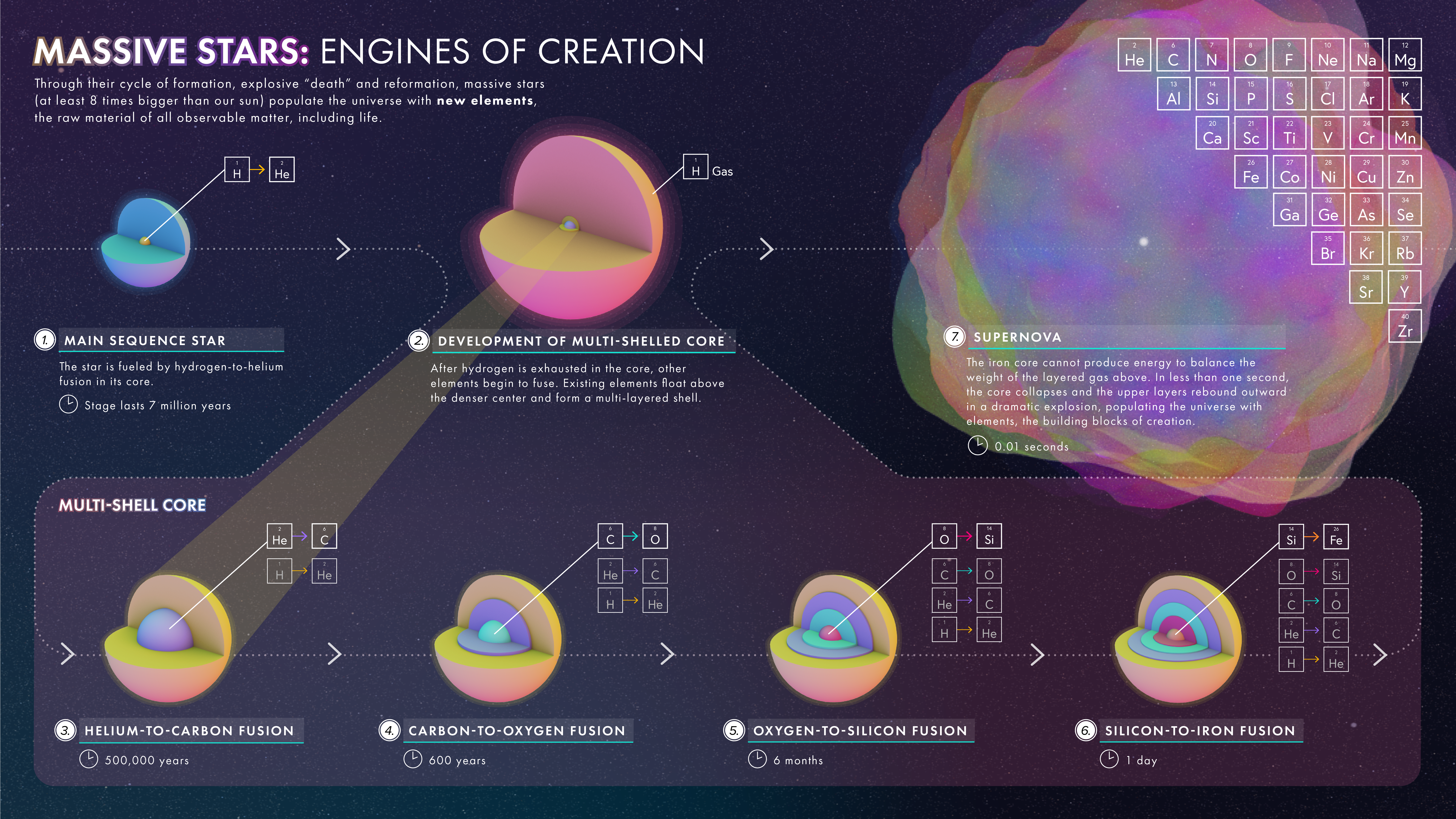
Extended Description and Image Alt Text
Extended Description
Diagram that illustrates how massive stars create new elements. Headline in the top left reads “Massive Stars: Engines of Creation.” Underneath the headline is a caption that reads “Through their cycle of formation, explosive “death” and reformation, massive stars (at least 8 times bigger than our sun) populate the universe with new elements, the raw material of all observable matter, including life.” A sequence of illustrations depicts a stellar core over the lifetime of a star, and accompanying captions discuss the elements it forms through fusion reactions.
1. Main Sequence Star
Stage lasts 7 million years
The first image in the sequence, at the top left of the diagram, is of a small, purple-blue sphere, representing a star. It is cut open to expose a yellow core. Out of the yellow core is a line that points to a box with the chemical symbol for hydrogen: H and its atomic number: 1. This box points to another box with a yellow arrow that contains the chemical symbol for helium: H e and its atomic number: 2. The caption below reads “The star is fueled by hydrogen-to-helium fusion in its core.”
2. Development of Multi-shelled Core
The next image sits to the right of the first, in the middle of the diagram. It contains a large pink and yellow sphere, representing a star. It is cut open to expose a small core that has two layers: an outer yellow layer that is cut to expose a purple core. A line points from the pink and yellow sphere to a box with the chemical symbol for hydrogen: H and its atomic number: 1. To the box’s right is the word “Gas,” indicating that the star is mostly made of hydrogen gas. The caption below reads “After hydrogen is exhausted in the core, other elements begin to fuse. Existing elements float above the denser center and form a multi-layered shell.”
The next four images are grouped under the heading “Multi-shell Core” and illustrate what happens in the star’s core in greater detail.
3. Helium-to-Carbon Fusion
500,000 years
The first image in this group is located at the bottom left of the diagram. It shows the two-layered sphere from the previous image, with a yellow exterior cut to reveal a purple core.
From the purple core, a line points to a box containing the chemical symbol for helium: H e and its atomic number: 2. A purple arrow points from this box to another box containing the chemical symbol for carbon: C and its atomic number: 6.
Underneath are another pair of boxes. The left box contains the chemical symbol for hydrogen: H and its atomic number: 1. A yellow arrow points from this box to the box on the right, which contains the chemical symbol for helium: H e and its atomic number: 2.
4. Carbon-to-Oxygen Fusion
600 years
The second image in the “Multi-shell Core” group shows a three-layer sphere. Similar to the previous image, a yellow sphere is cut to reveal a purple sphere. In this illustration, the purple sphere is now cut to reveal a blue-green core.
From the blue-green core, a line points to a box that contains the chemical symbol for carbon: C and its atomic number: 6. A blue-green arrow points to another box containing the chemical symbol for oxygen: O and its atomic number: 8.
Underneath are two pairs of boxes. The left box in the first pair contains the chemical symbol for helium: H e and its atomic number: 2. A purple arrow points from this box to the box on the right, which contains the chemical symbol for carbon: C and its atomic number: 6.
Below this pair is another set of boxes. The left box contains the chemical symbol for hydrogen: H and its atomic number: 1. A yellow arrow points from this box to the next box, which contains the chemical symbol for helium: H e and its atomic number: 2.
5. Oxygen-to-Silicon Fusion
6 months
The third image in the group shows a four-layer sphere. Similar to the previous image, a yellow sphere is cut to reveal a purple sphere, which is cut to reveal a blue-green sphere. In this illustration, the blue-green layer is now cut to reveal a new, pink core.
A line points from the pink core to a box that contains the chemical symbol for oxygen: O and its atomic number: 8. A pink arrow leads from this box to another box that contains the chemical symbol for silicon: S i and its atomic number: 14.
Underneath are three pairs of boxes.
The first box within the first pair contains the chemical symbol for carbon: C and its atomic number: 6. A blue-green arrow points to another box containing the chemical symbol for oxygen: O and its atomic number: 8.
Underneath these two boxes is another pair of two boxes. The first box in this pair contains the chemical symbol for helium: H e and its atomic number: 2. A purple arrow points from this box to another box containing the chemical symbol for carbon: C and its atomic number: 6.
Below this pair is the last pair of boxes. The first box in this pair contains the chemical symbol for hydrogen: H and its atomic number: 1. A yellow arrow points from this box to the next box, which contains the chemical symbol for helium: H e and its atomic number: 2.
6. Silicon-to-Iron Fusion
1 day
The last image in the group shows a five-layer sphere. Similar to the previous image, a yellow sphere is cut to reveal a purple sphere, which is cut to reveal a blue-green sphere. The blue-green sphere is cut to reveal a pink sphere, which is now also cut to reveal an orange core.
A line points from the orange core to a box that contains the chemical symbol for silicon: S i and its atomic number: 14. An orange arrow points from this box to another box that contains the chemical symbol for iron: F e and its atomic number: 26.
Underneath are four pairs of boxes.
The first box in the first pair contains the chemical symbol for oxygen: O and its atomic number: 8. A pink arrow leads from this box to the second box, which contains the chemical symbol for silicon: S i and its atomic number: 14.
Below is the second pair of boxes. The box on the left contains the chemical symbol for carbon: C and its atomic number: 6. A blue-green arrow points to the second box, which contains the chemical symbol for oxygen: O and its atomic number: 8.
Underneath is the third pair of boxes. The left box contains the chemical symbol for helium: H e and its atomic number: 2. A purple arrow points from this box to the second box, which contains the chemical symbol for carbon: C and its atomic number: 6.
Underneath this pair is the last pair of boxes. The left box contains the chemical symbol for hydrogen: H and its atomic number: 1. A yellow arrow points from this box to the next box, which contains the chemical symbol for helium: H e and its atomic number: 2.
7. Supernova
0.01 seconds
The last image in the diagram, at the top right, displays a cloud of purple, pink, yellow, orange, and blue-green. The caption underneath reads “The iron core cannot produce energy to balance the weight of the layered gas above. In less than one second, the core collapses and the upper layers rebound outward in a dramatic explosion, populating the universe with elements, the building blocks of creation.” At the top right of the image are several boxes, displaying a variety of chemical symbols, including those for helium, and all of the elements between carbon (atomic number 6) and zirconium (atomic number 40).
Image Alt Text
Diagram showing the process of element creation within the cores of massive stars over their lifetimes. Massive stars build up a series of shells within their cores that fuse heavier and heavier elements, until the stars explode as supernovas.
- Release DateFebruary 28, 2019
- Science ReleaseNASA’s Webb Telescope Will Study an Iconic Supernova
- CreditImage: NASA, ESA, Leah Hustak (STScI)
Related Images & Videos

Multiwavelength View of Supernova 1987A (Hubble, Chandra, ALMA)
Astronomers combined observations from three different observatories (Atacama Large Millimeter/submillimeter Array, red; Hubble, green; Chandra X-ray Observatory, blue) to produce this colorful, multiwavelength image of the intricate remains of Supernova 1987A. Hubble image:...
Share
Details
Laura Betz
NASA’s Goddard Space Flight Center
Greenbelt, Maryland
laura.e.betz@nasa.gov
NASA, ESA, Leah Hustak (STScI)


